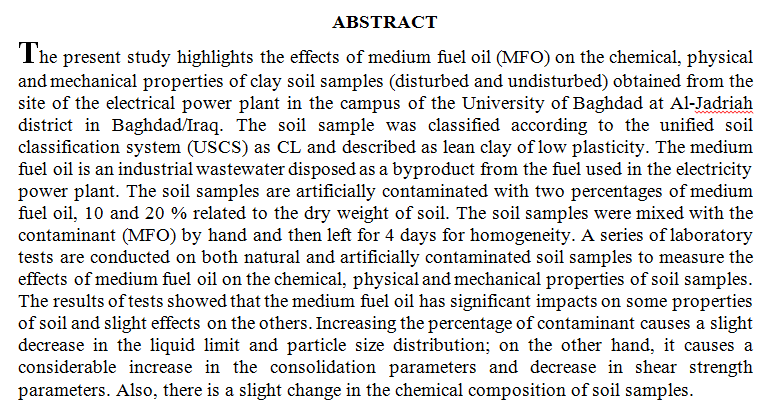
The aim of this research work is to study the effect of stabilizing gypseous soil, which covers vast areas in the middle, west and south parts of Iraq, using liquid asphalt on its strength properties to be used as a base course layer replacing the traditional materials of coarse aggregate and broken stones which are scarce at economical prices and hauling distances. Gypseous soil brought from Al-Ramadi City, west of Iraq, with gypsum content of 66.65%, medium curing cutback asphalt (MC-30), and hydrated lime are used in this study. The conducted tests on untreated and treated gypseous soil with different percentages of medium curing cutback asphalt (MC-30), water, and lime were: unconfined compression strength, and one dimensional confine
... Show More (8)
(8)
 (4)
(4)
 (6)
(6)
 (4)
(4)
In the present work, radon gas concentrations in different surface soil samples in Baghdad governorate were measured using RAD-7 detector. The results have been shown that, the Radon gas concentrations ranged between (41.67±1.78Bq/m3), to (185.67±4.22Bq/m3), a map showing the distribution of the concentration of radon in selected areas was defined to identify areas with high pollution level. The reason for the high concentration of radon is that these surface soil samples are taken from agricultural areas. It is also known that fertilizers contain uranium levels as well as areas bombed in wars in the country. It is worth noting that all radon concentrations in Baghdad governorate are below the recommended minimum of 200-300Bq/m3) (Inte
... Show MoreIn this study, the relationship between the bare soil temperature with respect to its salinity is presented, the bare soil feature is considered only by eliminating all other land features by classifying the site location by using the support vector machine algorithm, in the same time the salinity index that calculated from the spectral response from the satellite bands is calibrated using empirical salinity value calculated from field soil samples. A 2D probability density function is used to analyze the relationship between the temperature rising from the minimum temperature (from the sunrise time) due to the solar radiation duration tell the time of the satellite capturing the scene image and the calibrated salinity index is presented. T
... Show More (6)
(6)
 (4)
(4)
The present research deals with the spatial variance analysis in Jwartadistrict and conducting a comparison on the spatial and seasonal changes of the vegetation cover between (2007-2013) in order to deduce the relationship between the vegetation density and the areas which are exposed to the risk of water erosion by using Plant Variation Index NDVI) C (coefficient and by using Satellite images of Landsat satellite which are taken in 2/7/2007 and Satellite images of Landsat satellite taken in 11/1/ 2013, the programs of remote sensitivity and the Geographic Information Systems.
The study reveals that there is a variance in the density of vegetation cover of the area under study betwee 2007 and 2013. Howev
... Show MoreDrilling with casing (DWC) can be considered as a modern drilling technique in which both of drilling and casing operations done in the same time by using the casing to transfer the hydraulic and mechanical power to the bit instead of traditional drilling string. To overcome oil well control, minimizing the total cost through enhancing drilling efficiency, drilling with casing was proposed as an enabling technology.
Two surface sections (17 1/2 - and 12 1/4- inch) were drilled successfully in Rumaila oil field with casing strings which reached 655m and 1524m measured depths respectively.
By using DWC technique, the total drill/case phase time was reduced up to 20% comparing to conventional
... Show MoreThis work was conducted to study the extraction of eucalyptus oil from natural plants (Eucalyptus camaldulensis leaves) using water distillation method by Clevenger apparatus. The effects of main operating parameters were studied: time to reach equilibrium, temperature (70 to100°C), solvent to solid ratio (4:1 to 8:1 (v/w)), agitation speed (0 to 900 rpm), and particle size (0.5 to 2.5 cm) of the fresh leaves, to find the best processing conditions for achieving maximum oil yield. The results showed that the agitation speed of 900 rpm, temperature 100° C, with solvent to solid ratio 5:1 (v/w) of particle size 0.5 cm for 160 minute give the highest percentage of oil (46.25 wt.%). The extracted oil was examined by HPLC.
Cadmium Oxide and Bi doped Cadmium Oxide thin films are prepared by using the chemical spray pyrolysis technique a glass substrate at a temperature of (400?C) with volumetric concentration (2,4)%. The thickness of all prepared films is about (400±20) nm. Transmittance and Absorbance spectra are recorded in the wave length ranged (400-800) nm. The nature of electronic transitions is determined, it is found out that these films have directly allowed transition with an optical energy gap of (2.37( eV for CdO and ) 2.59, 2.62) eV for (2% ,4%) Bi doped CdO respectively. The optical constants have been evaluated before and after doping.
 (6)
(6)
The aim of this paper, study the effect of carbon nanotubes on the electrical properties of polyvinylchloride. Samples of polyvinylchloride carbon nanotubes composite prepared by using hot press technique. The weight percentages of carbon nanotubes are 0,5,10 and 20wt.%. Results showed that the D.C electrical conductivity increases with increasing of the weight percentages of carbon nanotubes. Also, the D.C electrical conductivity changed with increase temperature for different concentrations of carbon nanotubes. The activation energy of D.C electrical conductivity is decreased with increasing of carbon nanotubes concentration.
